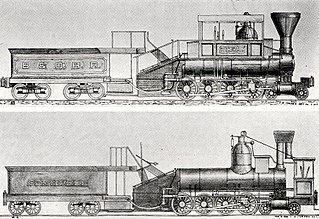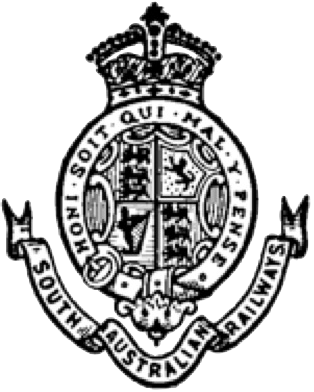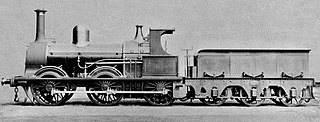
The Pichi Richi Railway is a 39 kilometres narrow-gauge heritage railway in the southern Flinders Ranges of South Australia between Quorn and Port Augusta. For much of its length the line lies in the picturesque Pichi Richi Pass, where the line was completed in 1879 as work proceeded north to build a railway to the "Red Centre" of Australia – the Central Australia Railway.

Under the Whyte notation for the classification of steam locomotives, 4-8-0 represents the wheel arrangement of four leading wheels on two axles, usually in a leading truck or bogie, eight powered and coupled driving wheels on four axles and no trailing wheels. In North America and in some other countries the type was usually known as the Twelve-wheeler.

The first railway in colonial South Australia was a line from the port of Goolwa on the River Murray to an ocean harbour at Port Elliot, which first operated in December 1853, before its completion in May 1854.

The London, Midland and Scottish Railway (LMS) Hughes Crab or Horwich Mogul is a class of mixed-traffic 2-6-0 steam locomotive built between 1926 and 1932. They are noted for their appearance with large steeply-angled cylinders to accommodate a restricted loading gauge.

South Australian Railways (SAR) was the statutory corporation through which the Government of South Australia built and operated railways in South Australia from 1854 until March 1978, when its non-urban railways were incorporated into Australian National, and its Adelaide urban lines were transferred to the State Transport Authority.
Under the Whyte notation for the classification of steam locomotives by wheel arrangement, a 4-8-2+2-8-4 is a Garratt articulated locomotive consisting of a pair of 4-8-2 engine units back to back, with the boiler and cab suspended between them. The 4-8-2 wheel arrangement has four leading wheels on two axles, usually in a leading bogie, eight powered and coupled driving wheels on four axles and two trailing wheels on one axle, usually in a trailing truck. Since the 4-8-2 type is generally known as a Mountain, the corresponding Garratt type is usually known as a Double Mountain.
The South Australian Railways 400 class was a class of 4-8-2+2-8-4 articulated steam locomotives built in France in 1952 and 1953 under licence to Beyer, Peacock & Co. Ltd, Manchester, UK. The locomotives mainly hauled ore on the 3 ft 6 in narrow gauge line from the SA/NSW border to smelters at Port Pirie until 1963, when they were replaced by diesel locomotives. They also operated on the lines to Terowie and Quorn. Some locomotives were returned to service in 1969 while narrow gauge diesel locomotives were converted to 4 ft 8+1⁄2 instandard gauge. Subsequently some were stored at Peterborough before being scrapped.

The South African Railways Class 19 4-8-2 of 1928 was a steam locomotive.

The South African Railways Class NG G16 2-6-2+2-6-2 was a narrow gauge steam locomotive.

The South African Railways Class NG G11 2-6-0+0-6-2 of 1919 is a narrow gauge steam locomotives.

The South African Railways Class 8B 4-8-0 of 1903 was a steam locomotive from the pre-Union era in Transvaal Colony.

The South Australian Railways Y class was a class of narrow gauge steam locomotives operated by the South Australian Railways.

The South African Railways Class NG6 4-4-0 of 1895 was an ex-Mozambican narrow-gauge steam locomotive from the Beira Railway era.

The South African Railways Class NG G12 2-6-2+2-6-2 of 1927 was an articulated narrow-gauge steam locomotive.

The South African Railways Class MH 2-6-6-2 of 1915 was an articulated Mallet-design steam locomotive.

The South Australian Railways W and Wx class was a class of 2-6-0 steam locomotives operated by the South Australian Railways. Some were used by the Commonwealth Railways in the Northern Territory and by contractors.

The two locomotives comprising the South Australian Railways J class were the only steam locomotives with a 0-6-0 wheel arrangement ever operated by the railway. They went into service in August 1875 and were condemned more than five decades later, in 1932 and 1934.

South Australian Railways locomotives 1, 2 and 3, the first locomotives delivered to the railway, arrived in time for deployment on the soon-to-be-opened Adelaide to Port Adelaide line. Built in 1855 by William Fairbairn & Sons in Manchester, UK, they arrived at Port Adelaide on the brig Theodore in November 1855, and were unloaded in January 1856; they were assembled and placed service in the succeeding three months. They were named Adelaide, Victoria and Albert but were numbered only after many years, and a locomotive class was never assigned to them.

Eighteen South Australian Railways K class (broad-gauge) locomotives were built by Beyer, Peacock and Company for the South Australian Railways (SAR) between 1878 and 1884. Despite having a fundamental design flaw that affected their original role as light-line passenger locomotives, they eventually performed shunting duties exclusively. They operated for six decades.

The South Australian Railways O Class (2nd) locomotive was a 4-4-0WT built by Robert Stephenson and Company in 1868 for the Launceston and Western Railway Company. It entered service with the South Australian Railways in 1912 and was cut up in 1930.





















